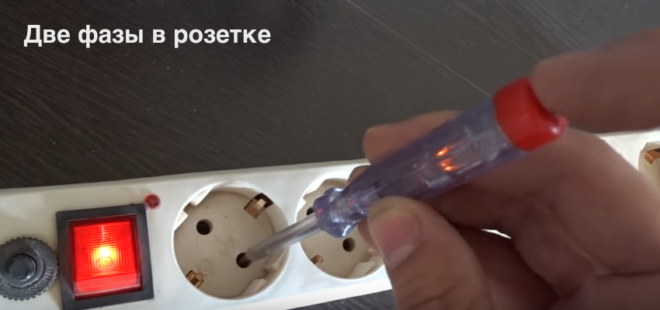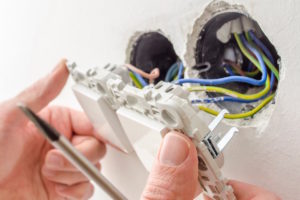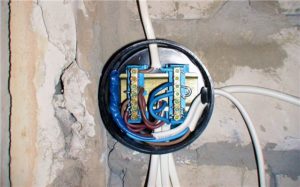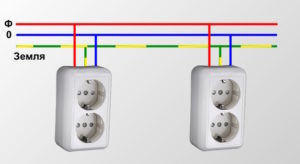Why two phases may appear in the outlet and what to do about it

Electrical wiring is done according to simple principles that are studied at school, but some malfunctions often go beyond the standard ideas about the operation of the electrical network. Two phases in the outlet is a common incident that regularly baffles users with insufficient experience in repairing electrical wiring.
Content
Where and why the second phase may appear
Here it is immediately necessary to make a reservation that since only one phase wire enters the apartment, the concept of "second phase" implies that the voltage indicator shows the phase in the contacts on which it should be initially and at zero. The second phase, in the correct understanding of these words, cannot be in the apartment.
The next point that you need to know to understand the essence of the problem is that every electrical device is a conductor of electricity. The simplest example is a light bulb - its filament glows due to the fact that it is a conductor of electric current. In fact, the light bulb shines because it closes the phase and zero together, and a short circuit does not occur since the incandescent filament has a certain electrical resistance. Other devices work in the same way - they are often connected to the network through transformers, the winding of which is made of copper wire. A short circuit, again, does not occur, since, due to the length of the wire and its cross section, it has an electrical resistance, but in fact, when a plug of any device is inserted into the outlet, the phase and zero are closed in it.
Now it should be clear why there are two phases in the outlet - this malfunction can appear only if there is no zero. The phase comes to the outlet, passes through an electrical appliance included in it and appears on the zero wire, and from it on those sockets that are located after the zero break. Accordingly, if you turn off all the switches and remove all the plugs from the sockets, the indicator will show the phase on only one contact.
As a result, a phase instead of zero may appear in one separate outlet (provided that it is double or triple and a plug of some electrical appliance is inserted into one of the plugs). Further, 2 phases can be in one of the rooms, in half of the apartment, or in general everywhere.
Also, the possibility of a short circuit cannot be discounted, for example, when drilling a wall or poor-quality wiring in a junction box. With some luck, you can hook the wiring so that the neutral wire burns off from the main network and sticks to the phase one. In this case, the indicator will show two phases in the socket even when the electrical appliances are disconnected from the mains.
In this video, you can watch how this malfunction is reproduced on a specially assembled stand:
Two phases in one socket
Such a case practically does not occur - this is a rare exception that proves the rule. If, nevertheless, this happened - all other sockets work flawlessly, there is light everywhere, and in one single outlet the indicator shows two phases, then first of all the outlet itself is disassembled. The breakdown will most likely be in another place, but first, just in case, you need to make sure that it is not in the place to which it is easiest to get.
If you are lucky, then a broken, burnt-out or jumped out of the mount wire will be found in the socket.
When the outlet is working properly and without traces of overheating of the wires, then the next step is to determine how it is connected - directly to the junction box or through another outlet.In the second case, there is a possibility that the neutral wire was screwed in poorly in the "parent" outlet, and now fell out.
Next, the junction box is checked - this is the most likely place where poor contact can be found. Here it must be borne in mind that the phase wire is not so demanding on the quality of the twist - with a poor connection, it heats up, but it still works for some time. The zero wire can oxidize without visible consequences - to see this, you will have to unwind the twists, re-strip the wires and collect everything back.
If the twist is in order, then it remains only to ring the wire with a tester - if it shows a break inside the wall, then you will have to break the strobe for repair.
When the outlet stops working in a house where the wiring is done recently and according to all the rules, then it is additionally worth checking if it is a power outlet to which a water heater or similar powerful device is connected. In this case, the reasons must be sought in the main switchboard, from where it can be powered, bypassing the junction boxes.
Two phases in multiple outlets
The situation is similar to the previous one, but now two phases are determined by the indicator in several outlets at once, often located in the same room. In this case, the lighting can either work or not, depending on the method of its connection.
There is no point in checking the sockets here, with one exception - if they are all connected by a so-called loop. In this case, the wires come from the junction box to one of them, and the rest are connected in series. PUE strongly does not recommend doing this, but everything can be.
The troubleshooting procedure depends on the desire to climb to the junction box and on whether there is a possibility of a daisy-chain connection. Most likely, a wire break will be found in the junction box, but if all the connections are normal there, then you need to disassemble all the sockets in the room one by one.
Two phases in half of the rooms
This happens if the junction boxes are connected in series one after the other. What to do in this case is a standard solution - you need to consistently go through all the boxes in search of a bad contact.
The difficulty is that often there is no connection diagram, so it is not known from which room and to which of them the wiring is laid. You should also take into account the option that the contact can burn both in the room in which the sockets do not work, and in the previous diagram, where the indicator shows normal voltage in the sockets.
There is a solution so as not to disassemble the terminal boxes in all rooms - you can change the phase and zero on the input panel, and then use a voltage indicator that can show the phase through the wall. Before that, you need to make sure that there is no zeroing in the outlets anywhere and, just in case, disconnect the grounding, if any.
Two phases in all sockets
If the lighting in the whole house has turned off, and the voltage indicator shows two phases in the sockets, the problem is most likely on the input panel.
In this case, it is imperative to check also the grounding wires in case they are neutralized. At the same time, until you are sure that there is no voltage on them, you cannot touch the grounding contacts with your bare hands and prohibit children from touching sockets and electrical appliances.
In old houses, plugs or circuit breakers are often installed, not only per phase, as recommended by the latest revisions of the PUE, but also on the neutral wire. Burnout of such a plug is tantamount to breaking zero, so it is recommended to check them first.
You also need to take into account the possibility of the absence of an electrical panel as such, when the wire from the meter goes directly to the main junction box - a faulty contact may be in it.
If everything is in order in the apartment, then the neutral wire on the floor switchboard is checked further - it is likely that for this you will have to invite an electrician from the housing office.









